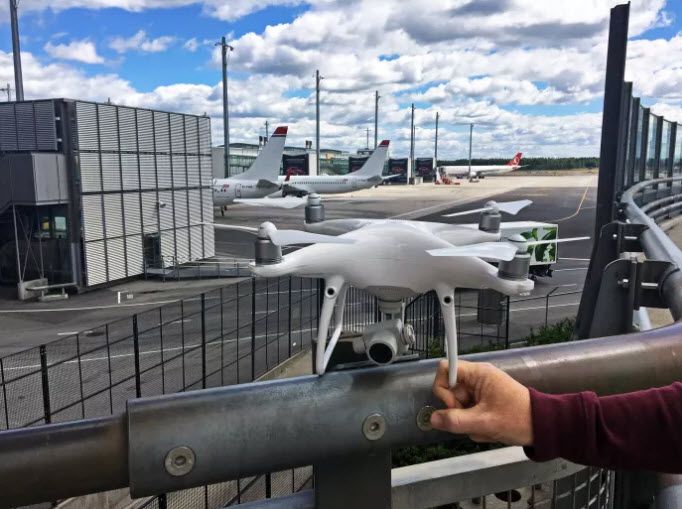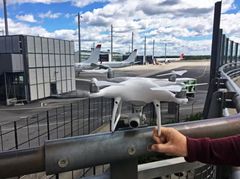The use of drones creates hazardous situations in aviation

In the beginning of June drones were flown in the immediate vicinity of Norway’s main airport, Avinor Oslo Airport. This is illegal and can lead to very dangerous situations.
On Wednesday 13 June there were two incidents of illegal drone use close to Oslo Airport, which led to the air traffic controllers closing the runways for air traffic for a period. Luckily, no harm was done this time, but the incidents have been reported to the police.
“We take these incidents very seriously. This is illegal, and we ask that everyone who owns and operates a drone to be careful, and not least to familiarise themselves with and respect the rules, says Henning Bråtebæk, Director of Airside Operations at Oslo Airport.
“For aircraft in the landing or take-off stage, drones constitute a particularly serious hazard, quite simply because the aircraft are so close to the ground that there is a real risk of a collision between aircraft and drone. This could lead to an adverse aviation incident or in the worst case a plane crash where a lot of people are endangered. As airport operator, Avinor must give air safety first priority. We have a low tolerance for situations that can endanger air safety.
The rules for flying drones are clear, and are available at both avinor.no/drone and at dronelek.no for amateur users.
Five key rules for the use of drones
- You must always keep the drone within your sights and fly it in a considerate manner. Never fly in the vicinity of accident sites.
- Do not fly closer than five kilometres from the outer fence of airports unless otherwise agreed.
- Do not fly higher than 120 metres above ground.
- Do not fly over festivals, military areas or sports events. Keep a distance of 150 metres.
- Respect the privacy of others. Remember the rules for using photos and video of other people.
Considering civil law action for damages
Reckless use of drones can also lead to severe consequences for air traffic. If an airport has to close because a drone is observed in the area, this may trigger liability for damages amounting to millions.
“The cost of closing a runway here at Oslo Airport for 30 minutes is significant and affects large numbers of people. On Wednesday some aircraft had to divert to Sandefjord Airport, Torp, because we had to close both runways here at Oslo Airport due to drones inside the no-fly zone,” Bråtebæk says.
We therefore report all incidents that affect Avinor’s airports to the police. We are also working on a policy related to liability in cases concerning violation of the drone rules. So far we have not submitted claims for damages in the cases we have reported, but this is being continuously assessed. We are also considering civil law action for damages against anyone who violates the drone rules around our airports.
Risk of prison
In one of the cases on Wednesday the police quickly got in touch with the drone pilot who caused one of the runways to close for air traffic in the morning.
“We take a very serious view of incidents relating to observations of drones within the no-fly zone. In one of the cases on Wednesday we had a good witness observation by a person on the ground who called to notify us, and then we were able to follow the drone and find the operator,” says Grethe Løland, station chief at Gardermoen Police Station.
“We spoke to the individual and he acknowledged the matter on the spot".
Violations of the rules can lead to serious personal consequences for the drone operator.
“You risk that the drone and equipment are seized, fines of up to NOK 20,000, in addition to possible imprisonment for the infraction,” Løland explains.
Løland also says that these matters are given high priority by the police.
“When air traffic control reports that drones are observed in the no-fly zone, we respond with the available resources and immediately start a search with the aim of finding the drone operator,” she explains.
“But to be able to find those flying illegally, we also depend on tips from the public so that we can initiate searches immediately to find the drone operator.”
May have serious consequences
It is the Civil Aviation Authority who is the legislative authority for Norwegian aviation and who has drawn up the rules for drone use in Norway.
“We know that the Civil Aviation Authority continuously assesses the rules, and the illegal actions of a few individuals may also have serious repercussions for all of the drone operators who comply with the rules,” Bråtebæk says.
The Civil Aviation Authority also takes a serious view of the incidents.
“It is extremely important that all drone operators understand that violations of the rules for flying drones can have serious consequences, both for air traffic and the drone operator. A collision between a drone and an aircraft could have a fatal outcome. It is up to the drone operator to familiarise himself with the rules, and the drone operator is himself responsible for any harm to persons and equipment,” says Bente Heggedal, head of the section for unmanned aviation with the Civil Aviation Authority.
Kontakter
Press contact numberPress service for journalists
Travellers are adviced to call our passenger service at +47 915 06 400
Joachim Westher AndersenHead of Communications
Tel:+47 918 15 614joachim.westher.andersen@avinor.noLasse André VangsteinCommunications Advisor / Press Spokesman Media Relations
Tel:+47 918 15 614lasse.andre.vangstein@avinor.noBilder

Om The Avinor Group
 The Avinor Group
The Avinor GroupDronning Eufemias gate 6
0191 Oslo
+47 67 03 00 00https://avinor.no/en/corporate/about-us/the-avinor-group/about-the-company
Følg pressemeldinger fra The Avinor Group
Registrer deg med din e-postadresse under for å få de nyeste sakene fra The Avinor Group på e-post fortløpende. Du kan melde deg av når som helst.
Siste pressemeldinger fra The Avinor Group
Opens flights after closed airspace25.4.2024 09:50:00 CEST | Press release
The error has been corrected and the airspace is gradually opening up to traffic. Due to the incident, there will unfortunately be delays throughout the day.
Will establish Norway as an international test arena for zero and low emission aviation.24.4.2024 09:00:00 CEST | Press release
[Oslo, 24 April] Avinor and the Norwegian Civil Aviation Authority have today entered into a cooperation agreement on the establishment of Norway as an international test arena for zero- and low-emission aircraft. The establishment will be a key measure for achieving the goal of fossil-free Norwegian aviation in 2050.
Passengers numbers increased significantly internationally, but decreased domestically in March10.4.2024 12:13:57 CEST | Pressemelding
5 million travelers used Avinor's airports in March. This is an increase of 1 percent compared to March last year. It is the international traffic that is increasing, with a whopping 12 percent. However, domestic traffic declined by 5 percent compared to March last year.
You decide: Which Edvard Munch painting do you want to see when arriving at Oslo Airport?12.3.2024 08:37:49 CET | Press release
For the first time ever, the public will decide which original Edvard Munch painting will be on display at Oslo airport, this summer and autumn.
Passenger figures for February: Strong growth internationally but flat development domestically11.3.2024 12:00:00 CET | Pressemelding
3.5 million travelers used Avinor's airports in February.
I vårt presserom finner du alle våre siste pressemeldinger, kontaktpersoner, bilder, dokumenter og annen relevant informasjon om oss.
Besøk vårt presserom